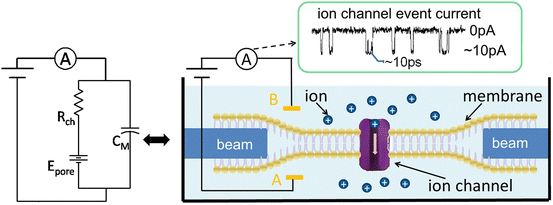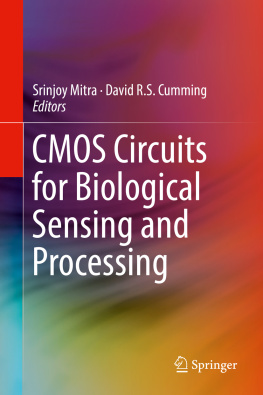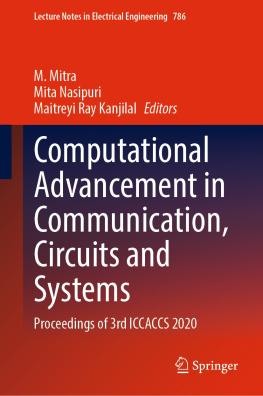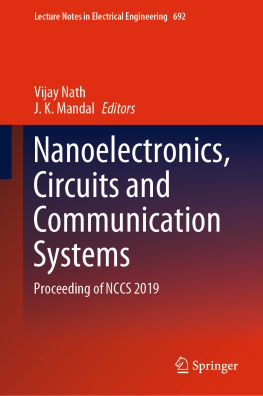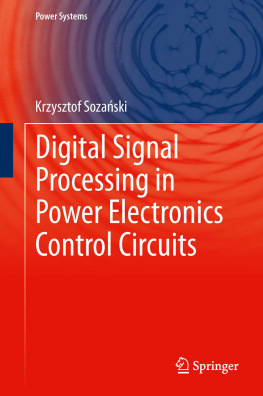Nano-Pore-Based Sensing
1.1 Introduction to Nano-Pore Sensing
Recently great research effort has been put into chemistry-enabled sensing systems such as air pollutant detectors, biosensors for antibody detection, as well as more complex emerging areas such as silicon nanowires []. Electrochemical biosensors are a subset that associate with and detect a biological event or a marker using charge transfer. Amperometric electrochemical biosensors detect this event by receiving the said charge through an electrode and transducing it into a current signal.
The information retrieved from electrochemical biosensors is usually integrated over a large number of charge transfers and integrated over time from individual electrodes [].
To enable single-molecule electrochemical detection, several methods have been proposed including redox cycling, nanoparticles, and nano-pores. A nano-pore is basically a nanoscale-sized path for charged or neutral particle transfer with well-defined flow characteristics []. As the demand to bring these technologies to the mainstream advances, there is a growing need for better understanding of nano-pores and their interfacing circuitry. The next sections of this chapter discuss the structure of nano-pores, especially ion channel proteins, and overview some of the challenges in developing electronic interfaces for nano-pores.
1.2 Nano-Pore Types and Implementations
Two main types of nano-pores are currently being used for amperometric measurements: ion channels and solid-state nano-pores. The first practical implementation of nano-pores was detection of single-stranded DNA molecules by passing them through a staphylococcal -hemolysin ion channel protein acting as a nano-pore gate [.
Fig. 1.1
Typical BLM populated with various membrane proteins source
The bulk of BLM is composed of amphiphilic phospholipids that are hydrophilic on one tail and hydrophobic on the other side. Accompanying these cells are the membrane proteins that are anchored to the surface and perform various tasks. Ion channels are one class of membrane protein, and they are the fundamental excitable elements in most cell membranes []. Their jobs include establishing a resting membrane potential and enabling action potentials by gating ions through the BLM. Thus, they are responsible for regulating cell volume and controlling ion flow across secretory and epithelial cells.
Solid-state nano-pores are another approach to nano-pore sensing. Due to recent advancements in microfabrication techniques, it is possible to implement microfabricated solid-state pores with nanometer-sized openings. An example of a nano-pore created on a silicon nitride surface is discussed in []. In terms of electrical properties and performance, there is not much difference between an ion channel and a microfabricated pore. Thus, throughout this chapter, the term nano-pores will generally refer to either of these structures.
Fig. 1.2
Solid-state nano-pore fabricated on a silicon substrate
1.3 Challenges in Nano-Pore-Based Sensing
Nano-pores transduce bio/chemical events into variations in ionic current flow that can vary in magnitude depending on factors such as the pore dimensions, viscosity of the analytes, capacitances stemming from the isolating layers or the electrodes, etc. Typically these ionic currents have an amplitude in pA region with timing characteristics, e.g., pulse width, as short as tens of microseconds. This imposes stringent limitations on the nano-pore interface system since the noise floor should at least be 10 dB lower than the signal level for it to be detectable. Hence a typical noise floor of fA levels is required for effective nano-pore sensing. For example, sodium ion channels typically have a conductance of 100 pS resulting in a current in the order of 10 pA when excited with a biasing voltage of 100 mV. As a result, they require a root-mean-square (RMS) noise level of less than 100 fA in a 1 kHz bandwidth []. However, this device is bulky, expensive, and designed for specific lab environments and experienced users. The limited existing instrumentation has created an obstacle for the development of nano-pore sensor that exploits their capabilities for precision measurement and single-molecule detection. However, as discussed in the next section of this chapter, recent advancements in CMOS technology and microfabrication techniques have enabled the opportunity to utilize custom CMOS circuitry for high-speed, low-noise, and cost-effective customizable alternatives to interfacing with nano-pore sensors.
CMOS Approaches for Nano-Pore Sensing
This section reviews solutions for characterization of nano-pores and detecting nano-pore events with a focus on addressing the challenge of interfacing these nano-pores through CMOS design. First, design considerations related to nano-pore working principles and methods of utilizing nano-pores as sensors from a physical and structural point of view will be discussed. Then, the most effective CMOS interfacing methods will be presented.
2.1 Electrical Model of Nano-Pores
Throughout this section, the electrical model of a conducting ion channel will be discussed. It is entirely possible to estimate the electrical behavior of a conducting ion channel as electrical components even though the component values would vary based on the overall nano-pore working conditions. The electrical model is valuable for understanding the basic behavior of ion channels under a given input voltage. The circuit equivalent of an ion channel implanted on a membrane is shown in Fig. ].
Fig. 1.3
Ion channel physical structure ( right ) with an equivalent circuit model ( left ) and current response during an amperometric test ( top )
A model for the voltage-current relationship of the conducting ion channel shown in Fig. ]:
where I pore is the total ionic current passing through the nano-pore under a given input voltage of E , g ion is the total channel conductance, and E pore is the equilibrium potential of the conducting nano-pore. By definition, if the nano-pore is conducting only a certain type of ion, E pore would be the total voltage gradient created inside the nano-pore due to the presence of ions passing through it, i.e., if the net voltage over the nano-pore is E pore, then the flux of ions through the pore will be zero. Notice that () only represents the equilibrium state of nano-pore operation and does not factor in the time constant R ch C M. Furthermore, the voltage-current relationship of nano-pores is nonlinear. For example, in case of an ion channel, the relationship is affected by variables such as diffusion currents due to higher concentration of permanent ions on one side of the pore.


